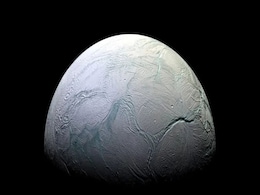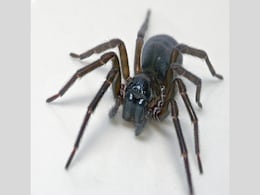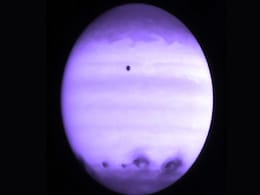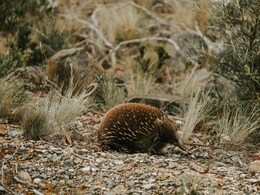Study On Evolution
- All
- News
- Videos
-

Study Reveals Ancient 26-Foot Shark Lived 115 Million Years Ago, Before Megalodon
- Sunday December 14, 2025
- Science | Edited by Astitva Raj
This discovery highlights the enormous size and predatory dominance of ancient sharks and provides scientists with a new perspective on the early evolution of the ancestors of today's great white sharks.
-
 www.ndtv.com
www.ndtv.com
-

JWST Detects Thick Atmosphere on Ultra-Hot Rocky Exoplanet TOI-561 b
- Sunday December 14, 2025
- Written by Gadgets 360 Staff
Astronomers using the James Webb Space Telescope have discovered compelling evidence of a thick atmosphere surrounding TOI-561 b, an ultra-hot rocky exoplanet orbiting its star every 11 hours. Despite extreme radiation and molten surface conditions, the planet appears cooler than expected, suggesting heat-redistributing atmospheric winds and volati...
-
 www.gadgets360.com
www.gadgets360.com
-

Mercury Has Shrunk by Several Kilometers Over Billions of Years, Scientists Report
- Tuesday August 19, 2025
- Written by Gadgets 360 Staff
Mercury’s surface reveals it has been shrinking for billions of years due to cooling and faulting. A new study estimates the planet’s radius has contracted by 2.7–5.6 kilometers, offering the most precise figures yet. The findings sharpen understanding of Mercury’s thermal evolution and could help scientists apply the same techniques to tec...
-
 www.gadgets360.com
www.gadgets360.com
-

Scientists Reconstruct Bust Of Woman From 10,500 Years Ago
- Thursday July 31, 2025
- World News | Agence France-Presse
Reborn via a close partnership between science and art, Mos'anne's bust was created at Belgium's Ghent University as part of a project to explore how the region's last hunter-gatherers lived during the Mesolithic era.
-
 www.ndtv.com
www.ndtv.com
-

Crystalline Ice Discovered in Space: New Study Reveals Hidden Order in Cosmic Ice
- Tuesday July 15, 2025
- Written by Gadgets 360 Staff
A groundbreaking study from University College London and the University of Cambridge reveals that water ice in space, long believed to be completely amorphous due to extreme cold, may actually contain up to 25% crystalline structure. Simulations and X-ray diffraction experiments confirm the presence of nanocrystals in so-called low-density amorpho...
-
 www.gadgets360.com
www.gadgets360.com
-

James Webb Telescope Spots Rare ‘Cosmic Owl’ Formed by Colliding Galaxies
- Monday July 14, 2025
- Written by Gadgets 360 Staff
NASA’s James Webb Space Telescope has unveiled the “Cosmic Owl,” a jaw-dropping image of two colliding ring galaxies forming a structure that resembles an owl’s face. This double-ring formation is extraordinarily rare, and the event is shedding light on galaxy evolution, black hole dynamics, and rapid star formation. Led by Ph.D. student Mi...
-
 www.gadgets360.com
www.gadgets360.com
-

Feather-Legged Lace Weaver Spider Uses Toxic Silk Instead of Fangs to Kill Its Prey
- Wednesday June 18, 2025
- Written by Gadgets 360 Staff
A recent study reveals the feather-legged lace weaver spider doesn’t inject venom but instead kills by coating its prey with regurgitated toxins on silk. Despite lacking venom glands and ducts, this unique method proves equally lethal and may redefine how scientists understand spider evolution and prey capture strategies, according to findings pu...
-
 www.gadgets360.com
www.gadgets360.com
-

Teeth Hurt? It Could Be Because Of A 500-Million-Year-Old Fish
- Wednesday May 21, 2025
- World News | Agence France-Presse
Ever wondered why our teeth are so sensitive to pain or even just cold drinks? It might be because they first evolved for a very different purpose than chewing half a billion years ago, a study suggested Wednesday.
-
 www.ndtv.com
www.ndtv.com
-

Space Research Reveals How Icy Comets and Asteroids Could Reshape Earth-Like Planets
- Saturday May 3, 2025
- Written by Gadgets 360 Staff
New scientific models and telescope observations from 2024 and 2025 reveal how comet and asteroid impacts can change atmospheres on Earth-like exoplanets, potentially supporting life or triggering climate disruption.
-
 www.gadgets360.com
www.gadgets360.com
-

Echidna Species Lived Watery Lifestyles Like Platypuses: Study
- Tuesday April 29, 2025
- Feature | The Conversation
As the world's only surviving egg-laying mammals, Australasia's platypus and four echidna species are among the most extraordinary animals on Earth.
-
 www.ndtv.com
www.ndtv.com
-

Water on Ancient Mars? New Study Challenges the Cold Planet Theory
- Saturday April 26, 2025
- Written by Gadgets 360 Staff
Scientists have uncovered compelling evidence suggesting that early Mars was surprisingly wet, featuring extensive networks of lakes and river basins shaped by rainfall and snowfall. This challenges long-held views of a predominantly cold and icy ancient Mars. Despite current climate models struggling to explain sustained liquid water on the Red Pl...
-
 www.gadgets360.com
www.gadgets360.com
-

1 Trillion Species, 3 Billion Years: AI Helped Trace Bacteria Evolution On Earth
- Friday April 4, 2025
- World News | The Conversation
Bacteria consist of a single cell. They do not have bones and are not like big animals that leave clear signs in the geological record, which thankful palaeontologists can study many millions of years later.
-
 www.ndtv.com
www.ndtv.com
-

Iguanas Travelled 5,000 Miles to Fiji on Rafts 34 Million Years Ago
- Thursday March 20, 2025
- Written by Gadgets 360 Staff
Iguanas undertook a remarkable 5,000-mile journey from North America to Fiji around 34 million years ago. According to a new genetic study, these reptiles floated on rafts of vegetation, possibly due to extreme weather events. The research, published in PNAS, found that Fiji’s iguanas are closely related to North American species, contradicting e...
-
 www.gadgets360.com
www.gadgets360.com
-

Hubble Telescope Captures NGC 4536, a Starburst Galaxy with Intense Star Formation
- Wednesday March 26, 2025
- Written by Gadgets 360 Staff
NASA’s Hubble Space Telescope has captured a striking image of NGC 4536, a starburst galaxy 50 million light-years away in the Virgo constellation. The galaxy’s sweeping spiral arms are filled with young blue star clusters and ionized hydrogen gas, indicating rapid star formation. Astronomers believe its bar-like structure channels gas toward t...
-
 www.gadgets360.com
www.gadgets360.com
-

Smallest Galaxy Ever Found: Andromeda XXXV Defies Cosmic Evolution Models
- Thursday March 13, 2025
- Written by Gadgets 360 Staff
Astronomers have discovered Andromeda XXXV, the smallest and faintest known galaxy, located 3 million light-years away. It challenges existing models of galaxy formation, as similar small galaxies were thought to be destroyed in the early universe. Researchers are studying how it retained conditions for star formation despite harsh cosmic environme...
-
 www.gadgets360.com
www.gadgets360.com
-

Study Reveals Ancient 26-Foot Shark Lived 115 Million Years Ago, Before Megalodon
- Sunday December 14, 2025
- Science | Edited by Astitva Raj
This discovery highlights the enormous size and predatory dominance of ancient sharks and provides scientists with a new perspective on the early evolution of the ancestors of today's great white sharks.
-
 www.ndtv.com
www.ndtv.com
-

JWST Detects Thick Atmosphere on Ultra-Hot Rocky Exoplanet TOI-561 b
- Sunday December 14, 2025
- Written by Gadgets 360 Staff
Astronomers using the James Webb Space Telescope have discovered compelling evidence of a thick atmosphere surrounding TOI-561 b, an ultra-hot rocky exoplanet orbiting its star every 11 hours. Despite extreme radiation and molten surface conditions, the planet appears cooler than expected, suggesting heat-redistributing atmospheric winds and volati...
-
 www.gadgets360.com
www.gadgets360.com
-

Mercury Has Shrunk by Several Kilometers Over Billions of Years, Scientists Report
- Tuesday August 19, 2025
- Written by Gadgets 360 Staff
Mercury’s surface reveals it has been shrinking for billions of years due to cooling and faulting. A new study estimates the planet’s radius has contracted by 2.7–5.6 kilometers, offering the most precise figures yet. The findings sharpen understanding of Mercury’s thermal evolution and could help scientists apply the same techniques to tec...
-
 www.gadgets360.com
www.gadgets360.com
-

Scientists Reconstruct Bust Of Woman From 10,500 Years Ago
- Thursday July 31, 2025
- World News | Agence France-Presse
Reborn via a close partnership between science and art, Mos'anne's bust was created at Belgium's Ghent University as part of a project to explore how the region's last hunter-gatherers lived during the Mesolithic era.
-
 www.ndtv.com
www.ndtv.com
-

Crystalline Ice Discovered in Space: New Study Reveals Hidden Order in Cosmic Ice
- Tuesday July 15, 2025
- Written by Gadgets 360 Staff
A groundbreaking study from University College London and the University of Cambridge reveals that water ice in space, long believed to be completely amorphous due to extreme cold, may actually contain up to 25% crystalline structure. Simulations and X-ray diffraction experiments confirm the presence of nanocrystals in so-called low-density amorpho...
-
 www.gadgets360.com
www.gadgets360.com
-

James Webb Telescope Spots Rare ‘Cosmic Owl’ Formed by Colliding Galaxies
- Monday July 14, 2025
- Written by Gadgets 360 Staff
NASA’s James Webb Space Telescope has unveiled the “Cosmic Owl,” a jaw-dropping image of two colliding ring galaxies forming a structure that resembles an owl’s face. This double-ring formation is extraordinarily rare, and the event is shedding light on galaxy evolution, black hole dynamics, and rapid star formation. Led by Ph.D. student Mi...
-
 www.gadgets360.com
www.gadgets360.com
-

Feather-Legged Lace Weaver Spider Uses Toxic Silk Instead of Fangs to Kill Its Prey
- Wednesday June 18, 2025
- Written by Gadgets 360 Staff
A recent study reveals the feather-legged lace weaver spider doesn’t inject venom but instead kills by coating its prey with regurgitated toxins on silk. Despite lacking venom glands and ducts, this unique method proves equally lethal and may redefine how scientists understand spider evolution and prey capture strategies, according to findings pu...
-
 www.gadgets360.com
www.gadgets360.com
-

Teeth Hurt? It Could Be Because Of A 500-Million-Year-Old Fish
- Wednesday May 21, 2025
- World News | Agence France-Presse
Ever wondered why our teeth are so sensitive to pain or even just cold drinks? It might be because they first evolved for a very different purpose than chewing half a billion years ago, a study suggested Wednesday.
-
 www.ndtv.com
www.ndtv.com
-

Space Research Reveals How Icy Comets and Asteroids Could Reshape Earth-Like Planets
- Saturday May 3, 2025
- Written by Gadgets 360 Staff
New scientific models and telescope observations from 2024 and 2025 reveal how comet and asteroid impacts can change atmospheres on Earth-like exoplanets, potentially supporting life or triggering climate disruption.
-
 www.gadgets360.com
www.gadgets360.com
-

Echidna Species Lived Watery Lifestyles Like Platypuses: Study
- Tuesday April 29, 2025
- Feature | The Conversation
As the world's only surviving egg-laying mammals, Australasia's platypus and four echidna species are among the most extraordinary animals on Earth.
-
 www.ndtv.com
www.ndtv.com
-

Water on Ancient Mars? New Study Challenges the Cold Planet Theory
- Saturday April 26, 2025
- Written by Gadgets 360 Staff
Scientists have uncovered compelling evidence suggesting that early Mars was surprisingly wet, featuring extensive networks of lakes and river basins shaped by rainfall and snowfall. This challenges long-held views of a predominantly cold and icy ancient Mars. Despite current climate models struggling to explain sustained liquid water on the Red Pl...
-
 www.gadgets360.com
www.gadgets360.com
-

1 Trillion Species, 3 Billion Years: AI Helped Trace Bacteria Evolution On Earth
- Friday April 4, 2025
- World News | The Conversation
Bacteria consist of a single cell. They do not have bones and are not like big animals that leave clear signs in the geological record, which thankful palaeontologists can study many millions of years later.
-
 www.ndtv.com
www.ndtv.com
-

Iguanas Travelled 5,000 Miles to Fiji on Rafts 34 Million Years Ago
- Thursday March 20, 2025
- Written by Gadgets 360 Staff
Iguanas undertook a remarkable 5,000-mile journey from North America to Fiji around 34 million years ago. According to a new genetic study, these reptiles floated on rafts of vegetation, possibly due to extreme weather events. The research, published in PNAS, found that Fiji’s iguanas are closely related to North American species, contradicting e...
-
 www.gadgets360.com
www.gadgets360.com
-

Hubble Telescope Captures NGC 4536, a Starburst Galaxy with Intense Star Formation
- Wednesday March 26, 2025
- Written by Gadgets 360 Staff
NASA’s Hubble Space Telescope has captured a striking image of NGC 4536, a starburst galaxy 50 million light-years away in the Virgo constellation. The galaxy’s sweeping spiral arms are filled with young blue star clusters and ionized hydrogen gas, indicating rapid star formation. Astronomers believe its bar-like structure channels gas toward t...
-
 www.gadgets360.com
www.gadgets360.com
-

Smallest Galaxy Ever Found: Andromeda XXXV Defies Cosmic Evolution Models
- Thursday March 13, 2025
- Written by Gadgets 360 Staff
Astronomers have discovered Andromeda XXXV, the smallest and faintest known galaxy, located 3 million light-years away. It challenges existing models of galaxy formation, as similar small galaxies were thought to be destroyed in the early universe. Researchers are studying how it retained conditions for star formation despite harsh cosmic environme...
-
 www.gadgets360.com
www.gadgets360.com



















